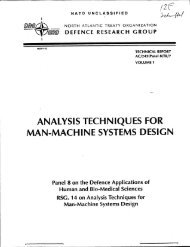Iterative Weighted Risk Estimation for Nonlinear Image Restoration ...
Iterative Weighted Risk Estimation for Nonlinear Image Restoration ...
Iterative Weighted Risk Estimation for Nonlinear Image Restoration ...
Create successful ePaper yourself
Turn your PDF publications into a flip-book with our unique Google optimized e-Paper software.
3. SELECTION OF REGULARIZATION PARAMETER β3.1 Generalized Cross Validation (GCV)GCV 2 is an attractive method <strong>for</strong> selecting β, especially in the context of linear algorithms. Fora generic linear reconstruction of the <strong>for</strong>m, f β (y) =F β y (F β is matrix representing some type ofinverse filtering), GCV selects β by minimizingGCV(β) = N −1 ||Af β (y) − y|| 2(1 − N −1 tr{AF β }) 2 . (6)Calculation of the trace, tr{AF β } in the denominator of (6), can be per<strong>for</strong>med either analyticallyin some special cases, e.g., when F β is circulant, or stochastically using Monte-Carlo methods 17 <strong>for</strong>a general F β . GCV(β) is simple to implement and is know to yield β that asymptotically providesan optimal reconstruction <strong>for</strong> linear algorithms. 2For nonlinear algorithms (denoted by f β ), Deshpande et al. 3 proposed the following NGCVmeasure 3, 4 (GCV <strong>for</strong> nonlinear algorithms) based on the principles of cross-validation:NGCV(β) = N −1 ‖y − Af β (y)‖ 2 2(1 − N −1 tr{AJ fβ (y)}) 2 , (7)where J fβ (y) is the Jacobian matrix consisting of partial derivatives of the components {f β,n (y)} N n=1of f β (y) with respect to the components {y n } N n=1 of y: thekl-th element of J fβ (y) isgivenby[J fβ (y)] kl = ∂f β,k(z)∂z l∣∣∣∣z=y. (8)NGCV(β) is a generalization of GCV(β) <strong>for</strong> nonlinear algorithms. 3, 4 It is more involved andcomputation intensive compared to GCV(β) (6) as it requires the evaluation of J fβ (y).3.2 Stein’s Principle <strong>for</strong> Estimating MSE-type MeasuresIn image reconstruction problems, mean squared error (MSE),MSE(β) △ = N −1 ‖x − f β (y)‖ 2 2, (9)is commonly used to determine quality of a reconstructed image and is an attractive alternative to(N)GCV <strong>for</strong> tuning β. However, MSE(β) cannot be directly used in practice due to its dependenceon the unknown x. For denoising applications, i.e., A = I N in (1), one can use Stein’s principle ∗to estimate MSE(β) when noise is modeled as Gaussian. This process leads to the so-called Stein’sUnbiased <strong>Risk</strong> Estimate (SURE) 5, 9 given by SURE(β) =N −1 ‖y−f β (y)‖ 2 2−σ 2 +2σ 2 N −1 tr{J fβ (y)}.SURE(β) is unbiased, i.e., E b {MSE(β)} = E b {SURE(β)} (where E b {·} denotes the expectationoperation with respect to b), but requires the knowledge of the noise variance σ 2 unlike (N)GCV.Evaluation of J fβ (y) inSURE(β) can be per<strong>for</strong>med analytically <strong>for</strong> some special nonlinear denoisingalgorithms (e.g., wavelets-based denoising 9 and nonlocal means 11 ) or numerically using the Monte-Carlo method 10 <strong>for</strong> an arbitrary linear/nonlinear, iterative/noniterative algorithm f β .∗ Application of Stein’s principle requires the hypotheses that f β is (weakly) differentiable 6, 9 and decayssufficiently rapidly 6, 9 such that lim bn→∞ p(b)f β,n (y) =0∀ n, <strong>for</strong> the Gaussian probability density functionp(b) =(2πσ 2 ) −N/2 exp(−‖b‖ 2 2/2σ 2 ).SPIE-IS&T/ Vol. 8296 82960N-4Downloaded from SPIE Digital Library on 06 Apr 2012 to 141.213.236.110. Terms of Use: http://spiedl.org/terms
















